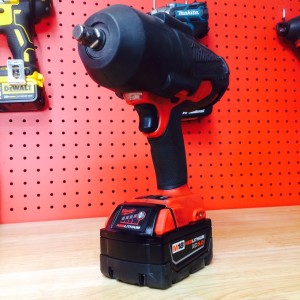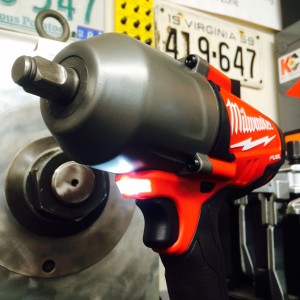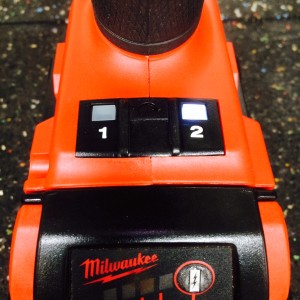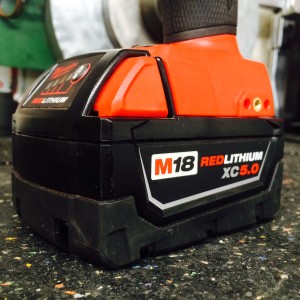In response to multiple viewer questions that we’ve recently received, specifically asking about long-term performance and power levels of cordless impact wrenches — we decided to run the 2+ year old Milwaukee M18 FUEL 2763 Brushless 1/2″ High-Torque Impact Wrench against a brand new version of the same model.
Looking at them side-by-side, the are identical except for dirt, grease, and a rubber protective boot (on the older version). Other than that, these are clones of each other — both being the tried & true 2763. This is “one of” the most powerful cordless impact wrenches on the market, and is designed to be a complete replacement for your pneumatic impact.
Here are the specs on the 2763 :
- Brushless Motor
- 1/2″ Drive
- “Hogring” / Friction Ring Anvil
- 18v
- M18 FUEL
- 2 Speed/Power Modes
- LED Light
- Variable Speed Trigger
- 10″ High
- 9″ Long
- 3″ Wide
- 7lbs 8.5oz (with 5.0XC Battery)
- 7lbs 14oz (with Battery & Boot)
The battery is on a slide-rail system like all the other M18 tools. Pressing in on both red tabs on the front of the battery & pulling forward will release it. Then, just slide a charged pack in the same way — once you hear the “click”, it is locked in & ready to go. If you need to check the status of the battery, simply press in on the button on the front & a range of LEDs will light up showing you the current charge.
Just above the trigger is a LED light. This is activated any time you press in on the trigger & also features a time delay. By barely pressing in on the trigger, the anvil wont turn — but the LED lights up. This will allow you to easily align the socket in a low light situation (such as changing a tire on the side of the road) & doubles as a flashlight. Also, since it is directly above the trigger — it aims the light right where you need it.
Unlike corded impact wrenches which typically are one speed (full on or full off), the 2763 has a variable speed trigger. So, if you would like to apply max power — pull it in fully. Or, if you need to “feather” it as you would with a pneumatic impact, you can do that also. Once you release the trigger, the electric brake stops the anvil almost instantly.
The 2763 has two different speed/power modes, which will allow you to use it in many situations where a single-speed (or simply variable speed) impact would not be safe to use. As with any powerful tool, it is easy to “overdo it” & when you are dealing with automotive repairs — a 2-second accident can quickly turn into an expensive all-day repair. By having two modes (low torque/low rpm & high torque/high rpm), Milwaukee was able to let you quickly switch between them & pick the right one for what you are working on.
Zipping off lugnuts or suspension bolts? Mode # 2 has a max range of over 1,000 ft-lbs reverse & over 800 ft-lbs forward — removing tough nuts/bolts extremely quickly.
Running on lugnuts of small fasteners? Mode # 1 has a max range of 100 ft-lbs to prevent accidental damage (i.e. – stretched bolts, stripped threads, etc).
Aside from the operation, the real intent of this review is to prove what the torque specs are — specifically when looking at a new impact VS one that is over 2yrs old. During that timeframe, the used 2763 has been loaned out to mechanics, seen extensive use here in the shop, and went through a wide range of torque testing many times. We have easily ran 4.0ah & 5.0ah batteries completely down with it between 100-200 times. However, it has always felt strong and we have not noticed any power loss.
To test the torque, we are using two different Skidmore Wilhelm units. These are one of the only ways to “prove” torque accurately, consistently, and repeatedly. One Skidmore is set up with a LH thread nut/bolt for reverse torque testing. The other is set up with a RH thread nut/bolt for forward torque testing.

For our side-by-side torque test, we decided to run these in the Mode #2 “High Torque” setting. (Previously we did test the Mode #1, and at max that mode will produce roughly 100 ft-lbs of torque). For the purposes of proving or disproving actual power loss, the higher numbers will be easier to read.
Starting out we ran the reverse torque test. Each impact was given 3 runs @ 15 seconds. We alternated impacts & batteries between each run, and changed out the lubrication on the back of the nut, the threads, and the washer face with a fresh coat of R-0050 Test Bolt Lube to ensure accurate results. Also, we used a brand new impact socket (Sunex #264) for the testing. After the reverse torque test, we switched to the second Skidmore for the forward torque test.
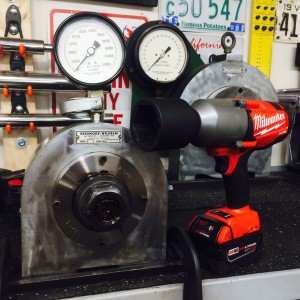
The results of the torque tests were averaged over 3 runs on each impact :
(New / Unused) 2763
- Mode # 2 (High Torque)
- Reverse Working Torque = 1,019 ft-lbs
- Forward Working Torque = 855 ft-lbs
(2yr Old Used) 2763
- Mode # 2 (High Torque)
- Reverse Working Torque = 1,036 ft-lbs
- Forward Working Torque = 862 ft-lbs
Shockingly, the older version beat the new impact in both torque tests! Running them side-by-side, we did not “feel” a difference in power levels, but after adding up the numbers it is clear — the M18 FUEL has suffered no power loss over the last two years!
This is very important — especially considering that pneumatic impact wrenches tend to be the strongest when new & continually drop in power/performance over time as they get dirty internally and wear out (eventually needing to be rebuilt). The 2763, even with a large amount of heavy use, performs as-good or better than a brand new model!
Like any Milwaukee cordless power tool, the 2763 carries a 5yr warranty against manufacturer defects (and the battery/charger carries a 3yr warranty). If you have any issues with them during that time-frame, contact Milwaukee & they will fix them for you free of charge!
If you are considering a cordless impact wrench, absolutely look at the Milwaukee M18 FUEL 2763 — you will not be disappointed!
Check out the full video review by clicking here!

